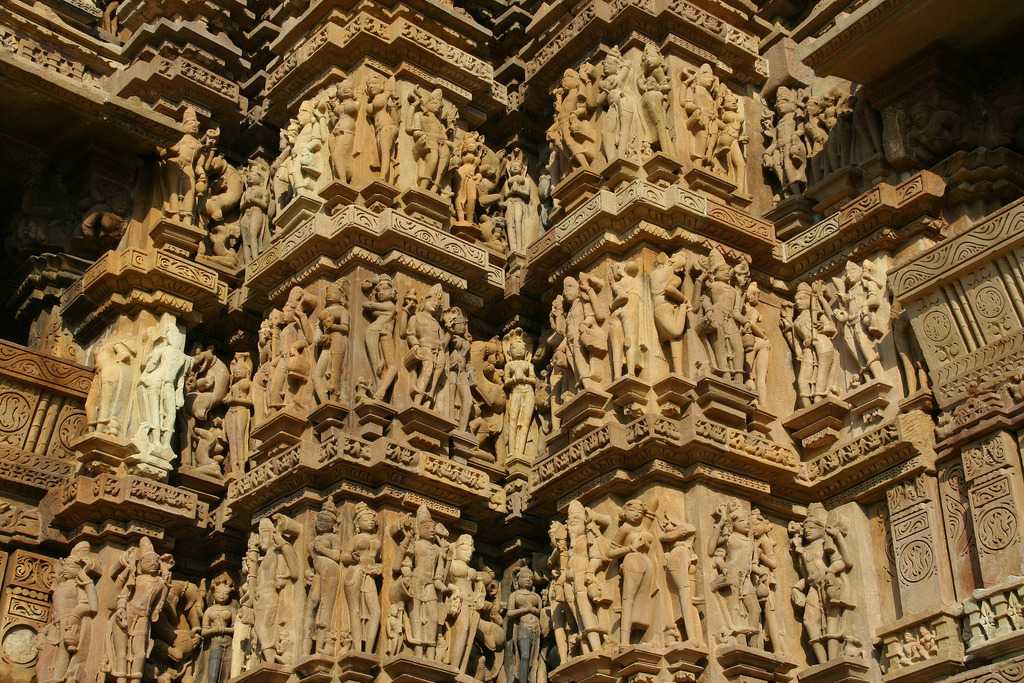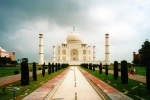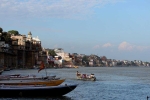"The Architectural Masterpiece"
Khajuraho Tourism
Khajuraho is known around the world for its stunning temples adorned by erotic and sensuous carvings.
A small town located in the Bundelkhand region inMadhya Pradesh, Khajuraho is a brilliant example of Indian architecture and its culture back in the medieval period. The architecture of these Hindu and Jain temples depict the innocent form of love, the carvings on the walls display passion in the most erotic yet aesthetic ways. Built between 950 to 1050 AD the sheer confrontational nature of these carvings show a stark paradox with the conventional Indian ideals about eroticism, leaving everybody spellbound. Art in this small town is engrained in all of its structures and are a classic example of the finesse of India's cultural and artistic heritage.
Download Khajuraho PDF Guide >
What's Great?
Abode to beautiful sculptures. A hotbed of ancient history.
What's not so Great?
Not easily accessible. Not much to explore for people not interested in architecture.
For Whom
Ideal for people who love architecture. Also perfect for people who are interested in history and culture.
Khajuraho - The Cultural Hotbed of Madhya Pradesh
Khajuraho is a cultural hotspot, situated in Chhatarpur district in the state of Madhya Pradesh. This is the site which houses remnants of the glorious history of ancient India, especially the famous series of Hindu & Jain Temples, created by the Chandela dynasty, that spoke volumes of the religious tolerance and generous hospitality that most of the Indians continue to practice for. No wonder why Khajuraho has also been accorded the status of a UNESCO World Heritage Site.
Khajuraho Temples & Caves
This is a prominent reason for the huge influx of tourists to Khajuraho. This site is chiefly famous for a series of Hindu & Jain Temples, constructed side by side, in a time span between 950 AD & 1050 AD, by the rulers of the Chandela dynasty. The site is an epitome of religious tolerance, with Hindu and Jain Temples coexisting side by side.
A striking feature of this famous site is the erotic sculpture, showing some postures of passionate love, as depicted in Vatsyayana's epic Kamasutra, as engraved on the walls. The best part about Khajuraho is that although scores of plunderers tried to destroy the whole complex, they could never succeed, even though they managed to reduce the number of temples and caves to 25 from a staggering 85 at the time it was created.
History Of Khajuraho
Chandela rulers built the temples of Khajuraho, one at a time spread over a period of hundred years. The first recorded mention of the temples can be founded in the writings of Abu Rihan-ul Biruni towards the end of the 11th century. Throughout the 12th century, the temple complex grew and later fell into the hands of the Sultan of Delhi, Qutb-uddin Aibak, after the downfall of the Chandela rulers. In the years to follow, the temples were preserved and tended by the Muslim rulers. Over the years some of the temples were vandalised and disfigured and were left unmonitored due to their deserted locations. T.S. Burt, a British engineer, later rediscovered the temples in 1830 and made efforts for their restoration.
Khajuraho Statues
The Chandela rulers originally built these temples to represent love and lust in the most pure forms. Some sculptures are bound to make you cringe, some will make you awe at the raw art, some will disappoint you and some will leave you in wonder.
There are several stories weaved around the erotic sculptures of Khajuraho. One of these stories suggest that the moon God got allured by the beauty of a maiden bathing in a lake under moonlight. She ran to the forest to seek refuge and raised her son alone. In turn, the moon God promised her son, a kingdom of his own. This theory claims that her son grew up to be the first Chandela ruler and influenced by her mother?s story, got the monuments constructed.
Some theorists believed that the Chandela dynasty used the sculptures as forms of sex education. Some say that the carvings are symbols for ?good luck?. Some suggest that the figurines much in love are only carved outside the temple and is a message that says to leave all lust and worldly pleasures behind before entering the temples, which in turn is a metaphor for ?moksha? (Hindu theory of salvation).
The sculptures are grouped into five broad categories-
The first ones are the Shilpshastras- the Jain tirthankaras.
The second category represent the deities, attendants, ganas, gandharvas, ashta dikpalas, among other images.
The third category represents the apsaras, also called the sapna sundaris. These are sculptures of really beautiful women doing mundane jobs like holding a baby, painting, dancing or just plain undressing.
The fourth category portrays scenes from everyday life- warriors, dancers, musicians, royal court, teacher, pupil etc.
The fifth and the final category has the very famous erotic images of unnatural sex, group sex etc.
Group Of Temples
The temple complex in Khajuraho is grouped into two categories based on their orientation- Western Group of Temples and Eastern Group of Temples. The Western group is more famous out of the two as it has the largest temple Kandariya Mahadeo Temple which is dedicated to the glory of Lord Shiva. The Western group mainly houses the temples dedicated to Hindu gods and goddesses. Among a large number of temples built in the complex, six are dedicated to Lord Shiva, eight are dedicated to Lord Vishnu, one each to Lord Ganesha and the Sun God, while three are dedicated to Jain Tirthankaras. All of these have beautiful intricate designs and boast of fine architecture and the very famous ever-so-elaborate sculptures.
The Eastern Group primarily has the four Jain temples- Parasvanath, Adinath, Shantinath and Ghantai dedicated to the worship of the Jain Tirthankaras.
Shopping In Khajuraho
To shop the right product at the right place, we suggest you visit the local flea markets. The major one of which is the Gole Market. There is also Oswal Complex and City Centre for touristy purchases. The city boasts of tradition and culture and we suggest you to go for the traditional souvenirs for your kins.
Khajuraho is popular for its textile produces mostly sarees. Remember to pick up a few from the local emporiums lined on the roads.
Another popular selling souvenir in Khajuraho is are the traditional handicrafts and handloom products. Plenty of stores sell tribal artefacts, brassware, paintings etc.
Another option is Miniature Stone Carved replicas of the sculptures in the temples.
Besides all of these, the street bazaars are flooding with funky jewellery, neckpieces, earrings etc.
Tip- As you are new and have little idea of the place, the locals might bluff you into paying them exorbitant prices. Make sure you bargain and haggle for the cost before you settle for something.
Itinerary
Day 1:You can begin your trip by taking a stroll in the local markets- Gole Market or Shilpgram, and collect souvenirs for your kins. You can spend the evening by the attending the light and sound show at the Western Group of Temples at the Khajuraho sites. The show explains all of the history and myths related to the temple complex. And, also answers most of your questions related to the historical site. It is a 50-minute show and runs both in Hindi and English.
Day 2:You can dedicate the entire next day taking time to stroll around the main temple complex and be awed by the beautiful carvings, figurines and sculptures. The complex is divided into two parts.
You can buy a ticket for the Western Group of Temples. It is a rectangular complex and houses some magnificent temples bound to charm you. You can also visit the museum at the far end of the temple complex.
Next, you visit the Eastern Group of Temples. It is a km away from the western group and has the old village of Khajuraho. It is a whitewashed plain village with one large red-orange statue within. The image is the monkey God Hanuman. It is believed to be the oldest image found in the whole of Khajuraho and is still worshipped with a lot of faith.
Restaurants and Local Food in Khajuraho
Khujuraho has countless delicacies that one must try, while here. Don't miss theKorma, Rogan Josh, Mutton Kababs, Chicken Biryani, Kheema, Sabudana Khichdi, Moong Dal Halwa, Jalebi, Cashew Barfi, Kusli, Lavang Lataand more. The area is known forBafla, a preparation of whole grain and 'ghee', traditionally followed by deliciousLadoos.Also sip into some local specialties such asLassi and Sugarcane Juice.Other than these local and traditional flavors, one finds here, Chinese, Indian, Italian, Greek, French, Spanish, South-Indian, Rajasthani and Moglai cuisines to indulge in.
View 5 Restaurants in Khajuraho >>
Jul-Maris the best time to visit Khajuraho
Winter season is the best season for a visit to Khajuraho, especially in the context of the outdoor activities. The months when Khajuraho is ideal for a trip is between October - March. Monsoons are also nice for a visit to the same, although the rainfall might dampen your trip plans. The summers, though, are the least advisable time for a visit, owing to the scorching heat and the unbearable humidity.
Weather in Khajuraho
Loading...
Khajuraho in Summer (April - June)
This is the least advisable time for a trip to Khajuraho. The days are scorching hot; the temperatures going as high as 45 degrees Celcius. Moreover, the humidity, which seeps in from June onwards, make the days unbearable for a visit.
Khajuraho in Monsoon (July - September)
The monsoon season lasts till September. This is not exactly the best time to visit Khajuraho, although the lush green site turns a paradise, thanks to the heavy rainfall. However being an offseason, there is a chance that you can avail great deals on hotel tariffs.
Khajuraho in Winter (October - March)
This is an ideal season for a visit to Khajuraho, with pleasant climate and cool ambience waiting for your arrival. Although the temperature might drop down to 4 degrees Celcius, the winter sun is absolutely welcome. You should especially visit this site in February when the famous Khajuraho Dance Festival actually begins.
Monthly Weather in Khajuraho
Month
Avg. Minimum (°C)
Avg. Maximum (°C)
January
11
24
February
14
29
March
18
34
April
25
41
May
28
42
June
28
40
July
25
31
August
24
30
September
25
32
October
20
33
November
14
30
December
11
26
Events in Khajuraho
Khajuraho Dance Festival
25th February - 3rd March
The magnificent Khajuraho Temples are lit up and beautiful classical dances are performed against this backdrop. From Kuchipudi to Bharatnatyam, From Kathakali to Odissi, dancers from all over the world will enthrall you with their performances.
Comments on Khajuraho
Post Your Comment


 Kandariya Mahadev Temple
Kandariya Mahadev Temple Light and sound show
Light and sound show Lakshman Temple
Lakshman Temple Devi jagdamba Temple
Devi jagdamba Temple Panna
Panna Agra
Agra Orchha
Orchha Varanasi
Varanasi Chitrakoot
Chitrakoot Pachmarhi
Pachmarhi